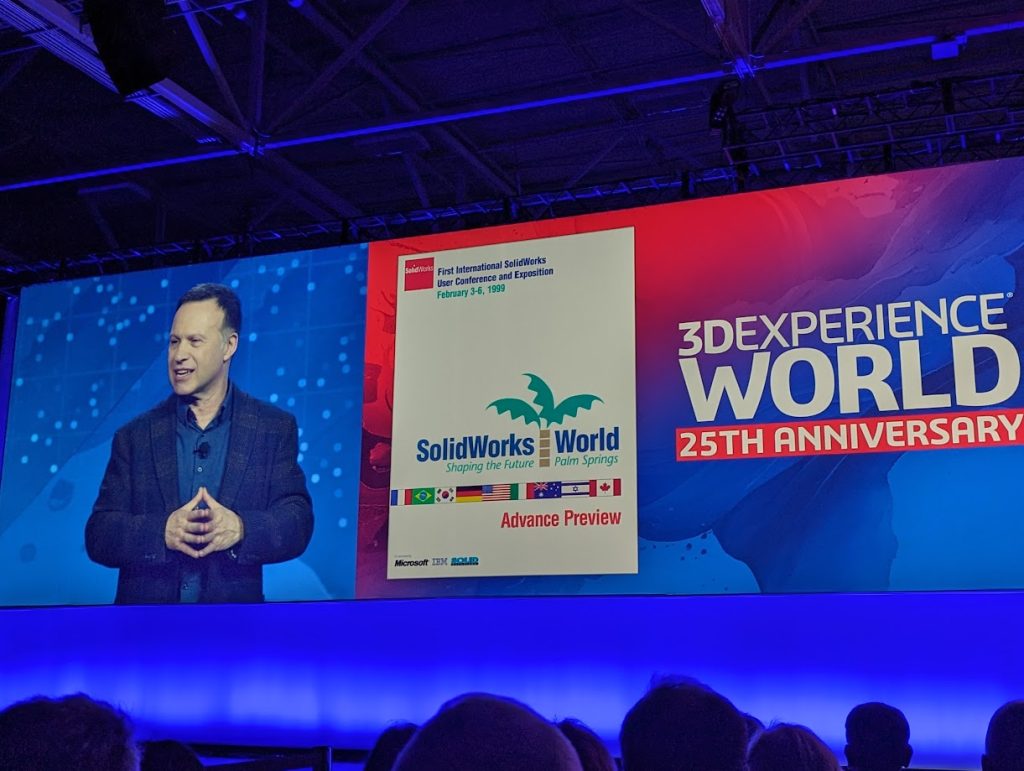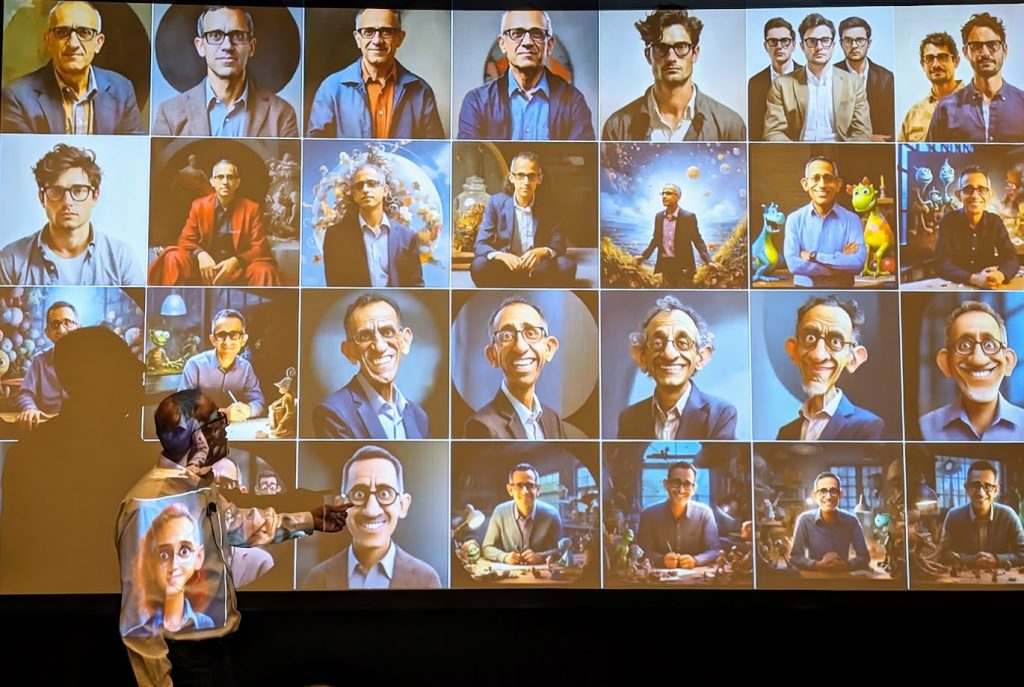How will AI intersect with the future of design? At the SolidWorks user event 3DExperience World 2024, Manish Kumar, the CEO of SolidWorks, and Gian Paolo Bassi, SVP at Dassault Systemes, tackled this question and others regarding the use of AI in industry.
This article, based on conversations at 2024’s 3DExperience World in Dallas, offers insight into the perspectives of key figures in the tech industry regarding AI’s role in engineering and design. Manish Kumar and Gian Paolo Bassi provided nuanced viewpoints on several topics, including the distinction between AI and generative AI, how AI and human creativity can be combined, and the future of engineering in the age of AI.
“The biggest misconception,” Kumar stated, “is when people start to correlate AI and generative AI as the same. It’s not. Generative AI is a tiny part.” He highlighted early instances of AI applications, such as text-to-image conversion used by the US Postal Service in the 1990s, to underline the history of AI technologies beyond the generative scope.
Kumar also pointed out the recent escalation in interest towards AI, crediting generative tools like ChatGPT for bringing AI to the mainstream. However, he cautioned against overlooking the broader capabilities and applications of AI. “There is nothing generative about if we are able to categorize things, if we are able to create collections,” he said, stressing the variety of AI functionalities.
Discussing SolidWorks’ own journey with AI, Kumar revealed that the company has been integrating AI features for some time. “We have been demonstrating it at least three to four years back,” he said, referring to predictive command and sketch auto-selection features previously seen as cutting-edge. The shifting perception of AI in the public eye, he noted, has transformed these once niche applications into central elements of software.
Kumar acknowledged the challenges and ongoing development of integrating AI into SolidWorks’ offerings, emphasizing a commitment to delivering generative capabilities by year-end. He also underscored that the development of these features predates the current generative AI hype, marking a long-term vision rather than a reactionary move.

Engineers Empowered by AI, Not Replaced
The CEO of SolidWorks argued that AI, despite its predictive prowess, cannot supplant the human capacity for imagination and creativity.
“AI is all about prediction based on what was done in the past,” Kumar noted, emphasizing that AI lacks the ability to envision entirely new concepts. What sets us apart… is that we are the only species on planet earth that is able to imagine, which is able to dream,” he asserted, pointing out AI’s limitation in innovating beyond its programmed data.
Discussing the strengths of machines, Kumar acknowledged their proficiency in memory retention, pattern recognition, and information translation. However, he pointed out that these capabilities make AI a complement to human skills, not a replacement. “Machines are very good at remembering things…but humans are a disaster,” Kumar said, indicating that AI can augment human weaknesses in data handling.
Kumar discussed the irreplaceable nature of human creativity and its role in innovation. “It’s the human aspect that promotes creativity,” he stated, explaining how misinterpretations and subjective understandings among humans lead to new ideas and progress. “If everyone tried to understand the same exact thing all the time, there would be no progress whatsoever,” he added, reinforcing the value of human diversity in thought and creativity.
For Kumar, the future of engineering and design is not threatened by AI but rather enhanced. “The mundane tasks will be done by AI, giving more time for innovation,” he explained.
The Role of AI in Enhancing Engineering
Gian Paolo Bassi, Senior Vice President at Dassault Systèmes, gave his take on common misconceptions and future challenges of AI in engineering.
“The biggest challenge is about misinformation. The advent of AI will have an effect similar to the Internet,” he said, highlighting the vast opportunities and access to knowledge AI brings, akin to the internet revolution. He stressed the importance of educating people to understand AI as a tool of immense potential, rather than a dystopian threat.
Addressing the specific role of AI in engineering, Bassi underscored the transformative impact AI can have on design and manufacturing. Reflecting on his engineering education, he pointed out that a significant part of an engineer’s job involves searching for information and answers, a task at which AI excels. “70-80% of the job of an engineer is to do the search. AI is very good at that,” he noted. However, Bassi also highlighted a critical distinction: while AI can provide answers, it is the human engineer who must ask the right questions. This division of labor between human curiosity and AI’s data-processing capabilities, according to Bassi, is where the real strength of this technology lies.
Echoing Bassi’s sentiments, Kumar added, “The engineer’s job is to find answers, not always know the answer.” This perspective reinforces the view that AI serves as a complement to human expertise in engineering rather than a replacement.
I questioned whether ChatGPT or other generative AI are stochastic parrots, tools that use probability to determine the next word, repeating back likely combinations based on training data, rather than genuine intelligence. “By definition, intelligence cannot be artificial,” says Bassi.

Suchit Jain, VP Strategy & Business Development at Dassault Systemes, led a detailed discussion with the assembled reporters on the topic of AI.
He highlighted significant user adoption of AI technologies, noting platforms like ChatGPT reaching 1.5 billion visits per month, illustrating AI’s mainstream appeal. A significant portion of his talk was dedicated to personalized AI tools, which allow users to create tailored versions of AI to suit specific needs. He shared his experiments with various AI-driven tools, including a custom chatbot that generates detailed product briefs and concept sketches, enhancing productivity and creativity.
Jain touched upon the challenges and opportunities in using AI for generating not just text but also images and potentially manufacturable 3D models. He emphasized the importance of prompt engineering and understanding AI capabilities to harness its full potential effectively.
Jain also discussed “Made by Me,” a tool that designs furniture using parameters set by the user, ensuring that all components are manufacturable by using readily available parts. This approach highlights a blend of generative and assistive AI, focusing on practical outputs within defined constraints. He shared insights into Dassault Systemes’ research and development efforts, including explorations into self-healing materials and cellular systems that mimic biological processes. These R&D projects represent forward-thinking applications of AI in materials science and engineering.
Looking toward future developments, Jain emphasized the ongoing improvements in natural language processing (NLP) that will enhance how humans interact with AI, making these interactions more seamless and intuitive. He also highlighted a new device expected to integrate various services without the need for specific APIs, suggesting a move towards more integrated, user-friendly technology solutions.

AI and Automation: Opportunities Rather Than Threats, Argue Dassault Systèmes and SolidWorks Executives
In response to concerns about AI’s impact on manufacturing jobs, Bassi and Kumar, offered a more optimistic perspective on technological advancement and employment.
Addressing data from PwC suggesting AI could reduce manufacturing jobs by a quarter, Bassi pointed to historical parallels in automation. “Automation caused a shortage of jobs all over the world but was a great opportunity for retooling,” he said. He challenged the narrative of job destruction by automation, arguing that advancements often lead to job creation in new areas. He cited the emergence of jobs in sectors like the circular economy due to automation.
Bassi further dismantled the dystopian depiction of automation displacing labor, contending that advancements have typically enhanced rather than replaced jobs. “Most information advances were able to improve the job, not to remove the job,” he observed. He also noted that contrary to popular belief, automation had less impact on entry-level jobs and more on higher-level tasks such as decision-making, a role traditionally associated with higher skill levels.

Balancing Data and Privacy in AI Systems
Among the complexities of implementing AI in engineering systems, data sourcing and privacy warrant a closer look.
Kumar explained how SolidWorks uses automation to create design elements for AI training. “We created 50,000 different bookshelves. It was created by automation, then we create drawings, using automation to feed into the AI model,” he said. This method allows SolidWorks to generate a vast amount of data for AI without infringing on customer privacy.
Additionally, Kumar highlighted an option for customers to contribute data to the system in an anonymized format. He compared this to salary surveys, where companies provide information without compromising individual details.
Bassi, on the other hand, discussed the balance between knowledge sharing and intellectual property protection. He recounted how customers’ shared knowledge has historically contributed to the improvement of software for the benefit of all, without compromising proprietary information. “Did we ever share that intellectual property? No.”
Regarding concerns about the societal impact of AI, particularly in the context of intellectual property, Kumar referred to a recent US copyright agency ruling. “Any work that is generative AI created work that cannot be copyright protected,” he explained, emphasizing the legal distinction between human-created and AI-generated work.
The conversations around AI bring to mind an observation by Marc Andreessen, now updated here for 2024. If software ate the world, AI is set to digest and optimize its nutrients.
Join the Expert Committee for the 2024 3D Printing Industry Awards to help select the winners!
What 3D printing trends do the industry leaders anticipate this year?
What does the Future of 3D printing hold for the next 10 years?
To stay up to date with the latest 3D printing news, don’t forget to subscribe to the 3D Printing Industry newsletter or follow us on Twitter, or like our page on Facebook.
While you’re here, why not subscribe to our Youtube channel? Featuring discussion, debriefs, video shorts, and webinar replays.
Featured image shows 3DExperience World 2024. Photo by Michael Petch.


